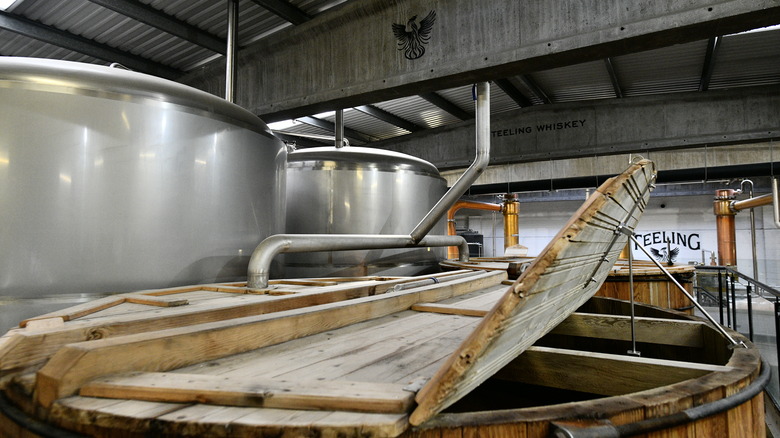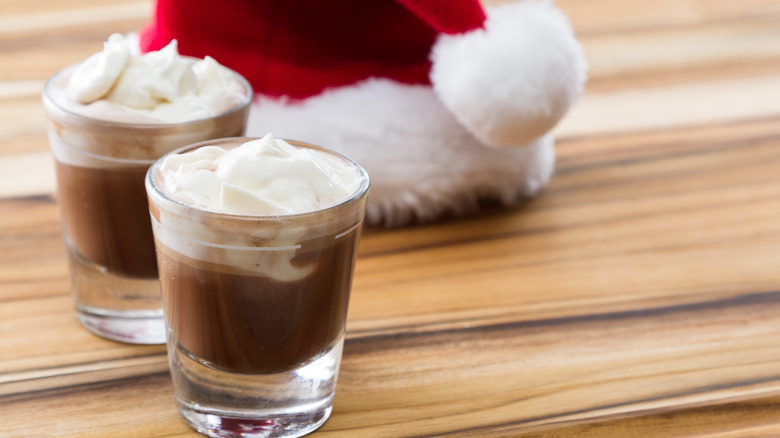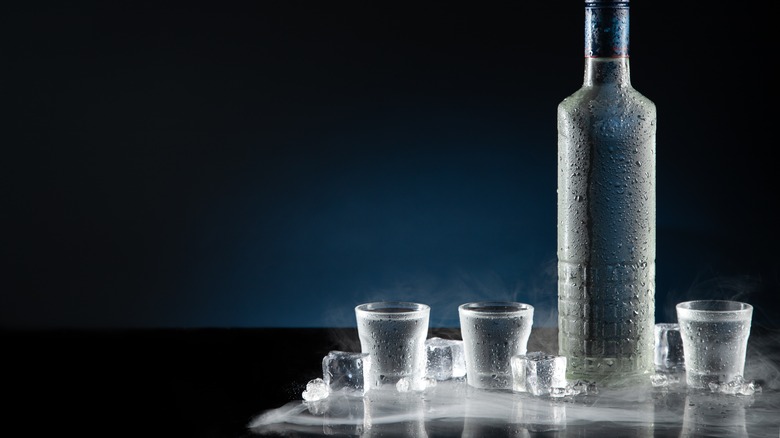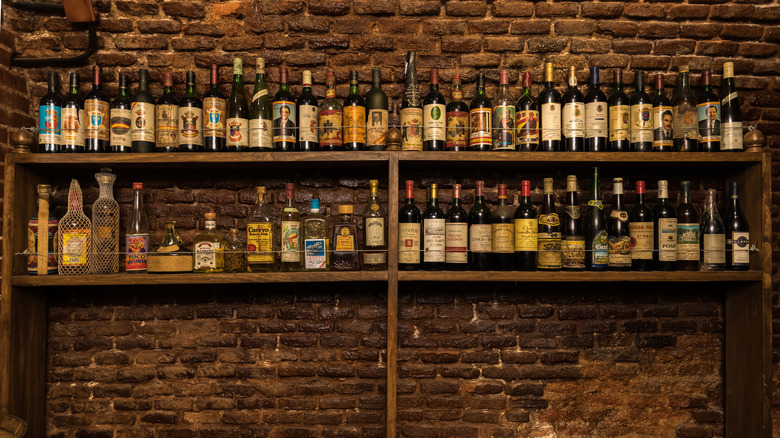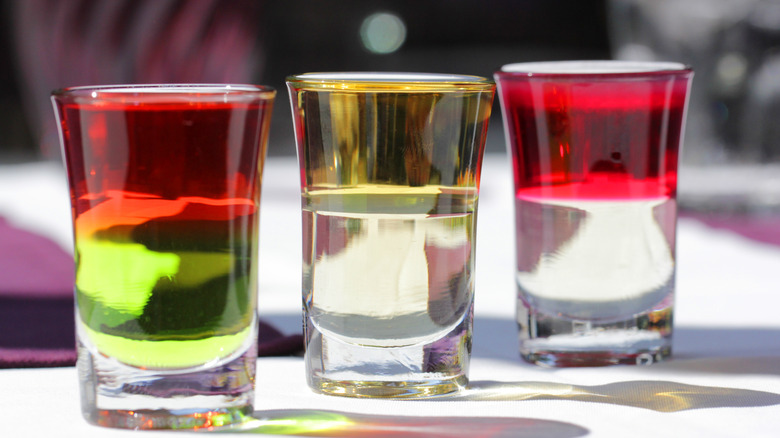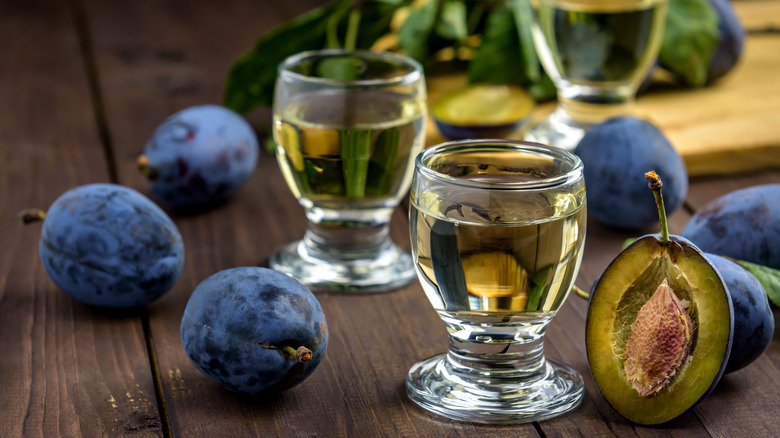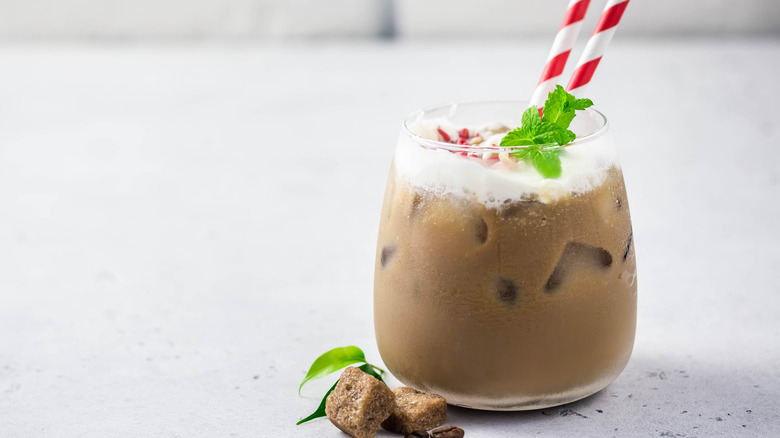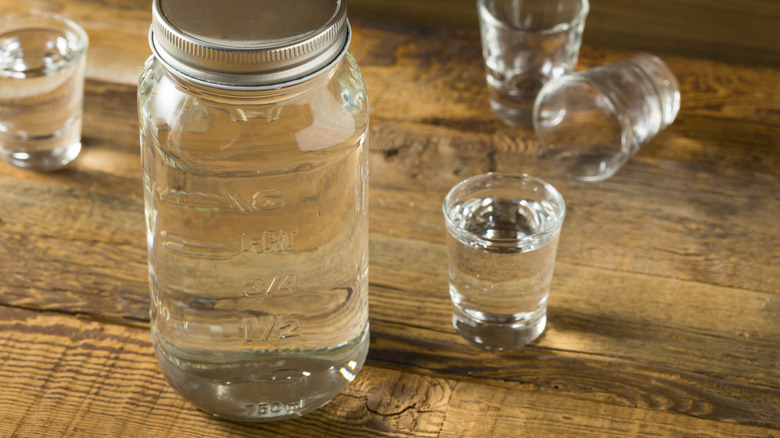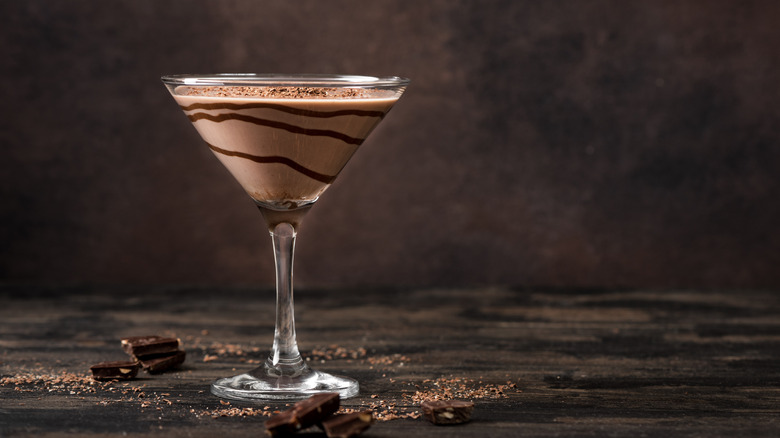Peppermint Schnapps: Everything You Need To Know
Many of us have fond (or not so fond) memories of peppermint schnapps as an alcoholic beverage that we often drank during our college days. And it's easy to see this drink serves this role so well: Sweet and clear with the familiar taste of peppermint candy, there's nothing "adult" about this adult beverage apart from its alcohol. Peppermint schnapps consists of a straightforward mix of neutral spirits with sweetening and peppermint flavoring (as per A Couple Cooks).
Unlike gin, scotch, or even wine, you don't have to acquire a taste for it, nor do you need a sophisticated beverage-tasting vocabulary to appreciate it. Additionally, many brands of peppermint schnapps are inexpensive and easy to find. Some brands of this drink are relatively low in alcohol (around 15% ABV), making them a gentle, easy-drinking pour. What's not to like if you're a budget-conscious undergraduate looking for a comforting way to get buzzed?
But even if your years of all-night cram sessions and Jell-O shots are long behind you, you might want to give peppermint schnapps another look: Yes, it can, indeed, be enjoyed non-ironically by people whose college days are behind them. If you're in the mood for peppermint schnapps, it's essential to ensure that you have all the necessary information to help you choose and enjoy your next bottle.
The origins of peppermint schnapps are murky
Some alcoholic beverages have unambiguous and memorable stories. Chartreuse, for example, was invented by the Chartreuse order of monks in France, and the famed Trappist ales of Belgium and France were (and still are) made by Trappist monks (per the American Homebrewers Association). Peppermint schnapps, however, has no such clear genealogy, and there are competing stories regarding its origins.
One story credits their invention to 18th-century French food scientist Nicolas-François Appert, a chef and confectioner best known for inventing the practice of sterile food canning and opening the world's first food canning facility. According to this account, Appert invented peppermint schnapps in 1810 as an ice-cream topping, but it only gained currency as a beverage when Napoleon's wife, Marie-Louise, took a liking to it and introduced the recipe to her native Austria.
A completely different account places the invention of peppermint schnapps in 1930s Minneapolis. Prohibition had ended just a few years before, so the only legally obtainable liquor was young and rough. A traveling salesman noticed bar customers dropping peppermint candies into their whiskey to improve its flavor, and this became the inspiration for peppermint schnapps. It's also possible that both stories are true, and both versions of the sweet, peppermint-flavored drink could have evolved independently of each other.
How peppermint schnapps is made
Peppermint schnapps has a well-earned reputation as an easily drinkable spirit because its flavor profile is so simple: Most varieties feature nothing more than peppermint flavoring, sweetener, and a neutral grain spirit (as per Can Can Awards). Some varieties may also use artificial flavorings and colorings, so check the labels when you're considering your choices.
Its alcoholic base of neutral grain spirits really allows the peppermint flavor to shine. The spirit is typically fermented and distilled from multiple types of grains, including corn, rye, wheat, barley, and rice, and the result is neutral in flavor (via Sasma 20). The multiple distillations remove any aroma from the original grain (via Golden Triangle Energy).
This makes it uninteresting (and way too strong) to drink on its own; however, it's useful for commercial liquor producers seeking a base for strongly flavored preparations such as gin. Since this spirit lacks flavor or aroma, it allows the scent of any aromatics (such as the peppermint in peppermint schnapps) to be blended and enjoyed unimpeded.
It's a great add-in for winter holiday drinks
Peppermint schnapps has an unmistakable candy cane flavor, which is perhaps why it is often associated with winter celebrations and holiday drinks. No ski trip would be complete without a steaming cup of hot chocolate laced with peppermint schnapps (a classic and easy preparation), and peppermint schnapps has made its way into numerous other hot and cold winter cocktails as well.
Chocolate is a frequent partner to peppermint schnapps in cocktails such as the Chocolate Peppermint Stick (peppermint schnapps, Irish cream liqueur, and crème de cacao) and the White Chocolate Peppermint Martini (peppermint schnapps, white crème de cacao, and vanilla vodka). But it also pairs well with other sweet flavors.
According to Onward State, the Candy Cane Martini combines peppermint schnapps with vanilla vodka and tonic water, and the Minty Mocha is a deceptively potent mix of peppermint schnapps, Kahlua, and Bailey's. No matter which of these drinks you choose, a candy cane garnish (or a glass rimmed with crushed candy cane dust) is always appropriate.
Peppermint schnapps also mixes well with sodas
While peppermint schnapps is best known as a winter drink, its cool, minty flavor makes it a refreshing and invigorating addition to lighter warm-weather cocktails as well, and this makes perfect sense when you consider the fact that mint leaves are often used as a garnish for summer cocktails.
Aficionados of peppermint schnapps have discovered that it pairs well with soda (such as Sprite) and even with Arizona lemon-flavored ice tea, a mixture that, according to its inventor, "sounds really weird, but I swear to god it's actually not bad." A more polarizing add-in for the warm weather (as one Redditor noted, "if you hate yourself") is orange juice.
A few of these lesser-known combos have gained enough staying power to have their own names. The Dr. Peppermint, for example, contains a can of Dr. Pepper with an ounce of peppermint schnapps. And if you're not afraid of adventure, a variation of this drink is the dubiously named Root Canal, which is made by mixing together Dr. Pepper, root beer schnapps, and peppermint schnapps. Whether or not any of these appeal to you, you can use these drink concoctions to experiment and create different cocktails: Peppermint schnapps may be more versatile than you think.
Some popular brands and how they taste
Like most alcoholic beverages, peppermint schnapps is available in a wide variety of brands and price points, with corresponding differences in flavor and character. While the high-end varieties are meant for serious sipping, easily obtainable mass-market brands can be used to make drinks like the Peppermint Patty (a shot of peppermint schnapps chased by a generous squirt of Hershey's syrup).
DeKuyper is of the best-known and most affordable brands, and a 750-milliliter bottle is sold for $9 (as per Total Wine & More). According to reviews on Drizly, it delivers exactly what drinkers expect: A straightforward peppermint sweetness that's a good addition to hot chocolate. One review stated, "It tastes like candy. I love this stuff," was a typical review.
Rumple Minze is another well-known brand with a very different profile. At 100 proof (50% ABV), it's significantly stronger than most other brands and a bit pricier. It's often enjoyed straight, but it can also be used in cocktails. "Not for the faint of heart" and "I love it, but it's not for everyone" are typical reviews on Drizly.
The Canadian brand Dr. McGillicuddy's is another well-known brand of peppermint schnapps (as per The Cocktail Bird). It has a lower alcohol content than Rumple Minze and a bracing minty finish. Many people also drink it straight: "When the doctor's in the house it brings everyone together, nice easy refreshing shots," said one review.
It's easy to store and it keeps well
Some home mixologists sometimes hesitate to add new bottles to their bars because they know they won't go through them very quickly and fear their contents will go bad while the bottle is still half full. And this is a real concern: According to Binwise, while unopened bottles of hard liquor can be kept indefinitely, once you open them, the clock starts ticking.
Opened bottles will maintain their quality for a year or two before the flavor and appearance of their contents start to degrade. They will still be safe to drink, although they may not be ideal for serving to guests.
However, Binwise advises that you can slow down this degradation by storing bottles at a moderate temperature in low light. Similarly, Still Tasty recommends storing schnapps with their lids tightly sealed in a "cool dry area away from direct head or sunlight." Other fans of peppermint schnapps, such as A Couple Cooks, recommend storing it in the refrigerator: This is both for preservation purposes and because it's best served and enjoyed cold.
Don't confuse peppermint schnapps with crème de menthe
Peppermint schnapps isn't the only sweet and minty drink out there. Crème de menthe has a similar flavor profile but a slightly different method of preparation: It's made from Corsican mint or dried mint that is infused in alcohol before being filtered and sweetened (as per The Cocktail Bird). And while peppermint schnapps is almost always clear, crème de menthe also has a green variant that contains more alcohol and additional aromatics, such as spearmint.
So what's the difference between them? In general, peppermint schnapps has a higher alcohol content and is more concentrated in flavor, so you'll get more of a minty blast on your palate with schnapps than with crème de menthe. Both can be used in cocktails, though not interchangeably (at least not without getting dramatically different results than what you might expect).
It's also worth noting that there can be a lot of variation within the flavor profile and alcohol level of different brands of peppermint schnapps. According to A Couple Cooks, they can range in ABV from 15% to 50%, so it's essential to check labels to ensure you're getting something that you will enjoy.
Peppermint schnapps is different from fruit schnapps
The term "schnapps" can be confusing because it refers to multiple, very different types of beverages (via Virginia Alcoholic Beverage Control Authority). Schnapps can be classified into four basic types: American-style schnapps, made with neutral grain spirits, sugar, and flavorings; imported German schnapps, unsweetened liquors distilled from fermented fruit such as pears or cherries; original recipe schnapps, based on traditional German home recipes for neutral spirits infused with herbs or fruit; and premium schnapps, made by distilling fruits (like imported German schnapps) or herbal infusion.
Peppermint schnapps falls squarely into the American-style schnapps category. So if you're a fan of peppermint schnapps and decide to order German-style fruit schnapps for a change of pace, don't expect a fruity version of the same drink. Instead, you'll get a much more intense, less sweet clear beverage.
Adventurous German distillers have flavored schnapps with everything from apples to asparagus to rosemary. However, according to The Cocktail Bird, peppermint-based alcohol has never really caught on among German drinkers.
You can make peppermint schnapps at home
In Europe, there's a long tradition of making schnapps at home by infusing neutral spirits with flavorings. According to The Cocktail Bird, peppermint wasn't among the flavors used in these traditional preparations; however, adventurous cooks can still easily (and quickly) make various versions of peppermint schnapps at home today. And unlike the traditional German preparations, making schnapps doesn't involve long periods of infusion, according to the Nashville Scene.
Nashville Scene's recipe is very simple: Just heat corn syrup and sugar together until the sugar is dissolved, then combine this with vodka and a small quantity of mint extract. (A little goes a long way: Only ¾ teaspoon of extract is needed for 2 cups of vodka.) According to an unscientific taste test by the Nashville Scene, the homemade version was superior to a store-bought bottle: It was sweeter and thicker, and it had a gentler flavor with less of an alcoholic burn. Even better, it tasted great in cocktails as well as neat.
The drink is part of an urban legend
Because it's so easy to drink, peppermint schnapps has earned a reputation as a party drink: Something to enjoy when you don't feel like thinking too hard about what you're drinking. This is probably why it makes a conspicuous cameo appearance in an improbable urban legend set in Nebraska.
According to the legend, two farmers, frustrated by marauding rabbits, procured a supply of powerful fireworks (each almost as potent as a stick of dynamite) along with a bottle of peppermint schnapps and decided to have some sadistic fun. As they swilled their schnapps, they trapped a bunch of rabbits, attached a stick of their newly acquired explosives to each with duct tape, then lit the fuses, hooting in satisfaction as each rabbit ran around in confusion before blowing up.
But one rabbit got the last laugh: Instead of running back into the field, it cowered under the brand-new pickup truck just acquired by one of the farmers, and when the poor rabbit blew up, so did the truck. Of course, peppermint schnapps had nothing to do with any of this: Any combination of booze and bad judgment would work, but the persistent presence of peppermint schnapps in various different versions of the story speaks to the popularity of this drink.
Peppermint schnapps can be stronger than it tastes
A shot of peppermint schnapps, with its sweet, candy-like flavor (and smooth mouthfeel), may feel as innocuous to consume as a Girl Scout cookie, but first impressions can be deceiving. As many a new drinker has discovered, peppermint schnapps can sneak up on you, and the effects won't be pretty. The tendency to underestimate the potency of peppermint schnapps is exacerbated by the fact that it's often mixed with other sweet, creamy, alcoholic ingredients, making it way too easy to slurp down multiple milkshake-like concoctions in a single sitting.
The good news is a little awareness of how much alcohol you're consuming will allow you to enjoy your drink while keeping you out of harm's way. Peppermint schnapps can vary greatly in alcoholic content: According to A Couple Cooks, it's available in three strengths: 30 proof (15% ABV), 60 proof (30% ABV), and 100 proof (50% ABV)). So, when shopping for peppermint schnapps, read the labels and be prudent when enjoying stronger varieties. And sip slowly: Not only will this make your drink last longer, but it will also help you enjoy the flavor much more.


